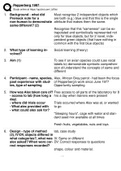Pepperberg 1987
Study online at https://quizlet.com/_bf0isi
1. Background - what did Must recognise 2 independent objects which
Premack note for a are both (e.g.) blue and that this is the single
non-human to demonstrate attribute that makes them the same.
same/different? (2)
Recognise that this "sameness" can be ex-
trapolated and symbolically represented not
only for blue objects, but for 2 novel, inde-
pendent green objects (that have nothing in
common with the first blue objects)
2. What type of learning in- Social learning (theory)
volved?
3. Aim (1) To see if an avian species could (use vocal
labels to) demonstrate symbolic comprehen-
sion of/understand the concepts of same and
different
4. Participant - name, species, Alex, African Grey parrot - had been the focus
past experience with stud- of Pepperberg's work since June 1977
ies, type of sampling Opportunity sampling
5. How was Alex taken care of? Free access to all parts of the laboratory for 8
- access to lab (how long a hrs a day when trainers were present
day)
- where did trials occur Trials occurred where Alex was at, or wanted
- What alex provided with to go
- what could alex ask for?
"Sleeping hours", cage with water and stan-
dard seed mix available at all times
Fresh fruits, vegetables, nuts and toys
6. Design - type of method lab, case study
(2), IV/DV, objects differed in
what categories?, what was IV: Same or different
alex asked? When were cor- DV: Correct responses to questions
rect responses recorded?
shape, colour and material.
1/9
, Pepperberg 1987
Study online at https://quizlet.com/_bf0isi
"What's same?" and "What's different?"
If Alex vocalised the appropriate category and
not the specific colour, shape or material. E.g.
say "Colour", not say "Blue" or "Yellow"
7. Since the appropriate cate- 1. Attend to multiple features of the objects
gory had to be stated, what
did Alex have to do (4) 2. Determine whether asked same or different
3. Work out what is same/different
4. Vocally produce a response
8. How long had alex learnt 9 years
"language" and concepts
for?
9. Pepperberg wanted to test novel ; laboratory repertoire
Alex on ___ objects as well,
that were not in _____
10. Name one colour, one shape Colour: green, red/rose, blue, yellow, grey
and one material Alex could
ALREADY vocalise b4 study Shape: 2-corners, 3-corners, 4-corners, 5-cor-
ners, football, triangular, square, pentagon
Material : paper, wood, (raw)hide, cork
11. Training (general) - what Model/Rival Technique
technique was used? what
is this technique based on? Social learning
12. Describe model/rival tech- trainer; responses; attention
nique
asked questions about the objects
One human acts as ____
to second human. Second praise/reward, disapproval
human modelled for alex'
2/9





